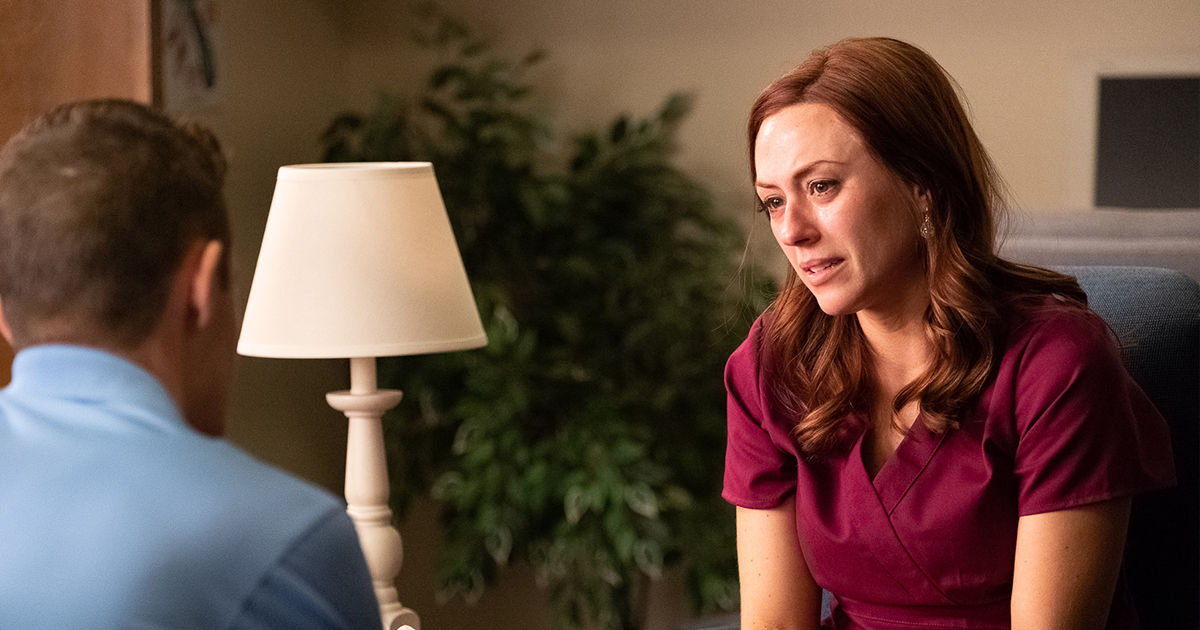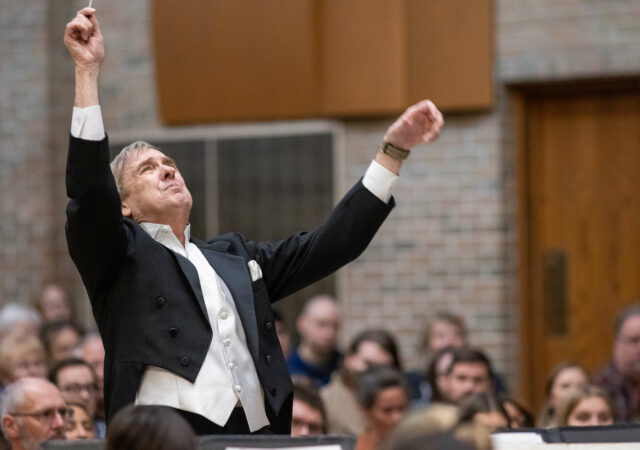
(Rated: R [Canada] and R [MPAA] for some disturbing/bloody images; directed by Chuck Konzelman, Cary Solomon; stars Ashley Bratcher, Brooks Ryan, Robia Scott; run time: 106 min.)
Horror and hope
By Holly Scheer
Spoiler/content alert: This film contains medically accurate and intense visuals of abortion procedures portrayed on screen. These scenes may be disturbing or difficult to watch for some viewers. The following review includes descriptions of these scenes that are intended to assist the reader in making an informed decision about seeing this film.
“Unplanned” tells the story of Abby Johnson (Ashley Bratcher), a former Planned Parenthood director who becomes pro-life after witnessing an ultrasound-guided abortion firsthand.
As depicted in the film, Johnson is first drawn to Planned Parenthood by a desire to help women after having had two abortions of her own, one of which was completed at home, leaving her upset that she was not informed by the clinic staff of what would happen.
Johnson’s work with Planned Parenthood begins with walking women from their cars past anti-abortion protesters on the sidewalk. Johnson quickly becomes successful in the organization, causing friction with her husband, Doug (Brooks Ryan), and her parents. She is made a clinic director when the current director moves on to a higher position, and she is later named Planned Parenthood Employee of the Year.
Johnson’s view on abortion abruptly changes when she witnesses the ultrasound-guided abortion of a 13-week old baby. Unable to morally reconcile the reality of what she has witnessed with the 22,000 abortions she has overseen at the clinic, she approaches Coalition for Life members Shawn Carney (Jared Lotz) and his future wife, Marilisa (Emma Elle Roberts), whom she previously met on the sidewalk while walking women into the clinic. She asks for their help leaving Planned Parenthood and goes on to face her family, her former employer in court, and her own conscience as she struggles to cope with her years of employment with America’s biggest abortion provider.
Faith and redemption
The film has a strong religious component throughout. The protesters outside of the clinic pray for the clinic workers and the women and babies inside the clinic. There is also a scene where protesters pray over large containers containing the bodies of babies being removed from the clinic.
The faith of the protesters is portrayed in a positive light. The relationship that grows over the years between the Carneys and Johnson, as Johnson ultimately joins the Carneys to pray on sidewalks after she leaves her work with the clinic, helps both Johnson and her family.
Johnson and her husband are shown returning to church after she leaves Planned Parenthood, and the renewed connection to the church helps her heal. Johnson’s life story shows the power of the Gospel and the importance of repentance, forgiveness and absolution. Viewers can expect to leave with a sense that Christ is in control, even when things seem hopeless.
Ground-breaking portrayals of abortion
“Gosnell: The Trial of America’s Biggest Serial Killer” was released in 2018 as America’s first big-screen look at abortionists. Gosnell was rated PG-13 for mature thematic content, including disturbing images and descriptions, particularly for depictions of the bodies of aborted babies and an unhygienic, dangerous clinic. The horror of the film was Gosnell’s callousness and disregard for safety and the shocking conditions that women endured under his care.
“Unplanned” is altogether different. The clinic is clean, the workers are chipper and friendly, and the decor is tasteful. The people there are normal, everyday people. The movie is meticulously researched and carefully filmed and takes the viewer inside a world where most pro-life people have never ventured.
There are four scenes that are particularly difficult and intense.
First is the ultrasound-guided abortion. Johnson is called into a procedure room to assist the doctor by holding the ultrasound probe against the mother’s stomach. The mother is shown crying, and the baby is shown on the ultrasound screen, fully formed and moving. The doctor who performs the abortion says, “Beam me up, Scotty” as he turns on the suction to abort the baby, and Johnson is upset and horrified by what she views. The scene culminates with Johnson running from the room, distraught.
The second disturbing scene in the film is a Planned Parenthood abortion that goes wrong. Johnson reassures a nervous, young girl and her father that things will be okay, but in recovery, the girl is seen bleeding in a chair onto the floor. Johnson notices and calls for help, and the girl is taken back into the procedure room. The clinic director, Cheryl (Robia Scott), does not allow the staff to call 911 for an ambulance, explaining that the protesters would see it. The girl is dangerously injured with a perforated uterus, and there are tense moments while the doctor works to save her life.
The third scene is Johnson’s own second abortion. After the abortion is started with pills in the clinic, Johnson is sent home to wait for the abortion to finish. She goes to bed and wakes up in a lot of pain, bleeding profusely and passing tissue (including her baby). Her bathroom is covered in her own blood, and she is pictured in the shower, bleeding heavily. This method of abortion, with a combination of the drugs mifepristone and misoprostol, is the most common form of abortion currently used in America.
The fourth scene that viewers are likely to find disturbing takes place in a room that the clinic staff calls “pieces of children” or POC. Planned Parenthood uses this acronym to stand for “products of conception.” In this room, Cheryl shows Johnson the body of a dead baby and hands her a tool so she can touch it. The body of the dead baby is visible in this scene.
Final thoughts
There has been much discussion about the film’s R rating, with some suggesting it is politically motivated, but the rating should be taken seriously. The movie contains material that is difficult to watch because abortion is the loss of human life, and the movie does not shy away from showing the horror of that loss.
This movie covers real-life, violent death, not pretend violence such as that seen in superhero movies. Not everyone will be emotionally equipped to see the strong visual images included in the movie. The decision of whether to see it is one that adults will have to make for themselves and parents will have to make for their children. For what it’s worth, while I am glad I saw the movie, I am still struggling with its story and images, and I will not be letting my 15-year-old view it.
Johnson’s time inside Planned Parenthood makes her a powerful pro-life voice. Her story is one that people need to see and learn from. This isn’t a movie only for those who already consider themselves strongly pro-life. It is a movie that looks honestly and deeply at the issue of abortion and has the potential to change minds and hearts. The more people who see it, the better — but you should see it knowing that it imparts difficult, painful truth.
Read more about Abby Johnson here.
Holly Scheer (hmscheer@me.com) is a pastor’s wife and mother of four.
Posted March 28, 2019





In some states a 15yr old girl can get an abortion without their parents consent. So it’s ok for them to experience the horrors of abortion without fully understanding what they are consenting to, but not to see a film that depicts those horrors?
My wife and I just saw the movie. It is powerful. Obviously it is going to speak Law to those who are complicit in the abortion industry. But it also calls Pro-Life Christians to repentance, as well. Too often we are quick to “hate” those who do evil, rather than praying for them and seeking God’s grace and forgiveness. The message of Life is a GOSPEL message; therefore it cannot be conveyed by the Law. If we want people to know that we love all life, it can start by loving those who are hardest (for us) to love.
I pray that every Lutheran high school in America will buy this video and show it to their students (presumably as part of a Theology class).
Go see it; and encourage everyone you know to see it. You won’t regret it!
I am very disappointed in this review. I believe it will cause many who would have seen it, to stay away. The whole movie is told here in explicit detail, robbing movie goers of the discovery of the story as it unfolds. Warning of the difficult parts to view in such detail will keep many who deny the reality of abortion or those who won’t get involved because it’s uncomfortable, away. This will result in keeping them from vital information and truth about abortion. This review does a disservice to the movie and its purpose.
Thank you for writing this review, it was very helpful for me in deciding whether or not I should go and see the movie. I do want to see it but I don’t think I can take anyone with me.
I have been President of a Pro-Life Society chapter in Canada and am well aware of the issues. I am glad that films of this kind are being made but I do think sometimes we need not put everything on display – for example The Passion of The Christ was unnecessarily, in my view, violent.
Phyllis, I agree and disagree. I have seen the movie and the descriptions of the “difficult” parts are accurate. I agree with the R rating. Abortion is violent. However, I disagree with the author’s decision to not take her 15 year old. That child should definitely see the truth of abortion. The Catholic school 8th graders in my city saw the movie. One father I know discussed the movie with his daughter and one of her main responses was her observation of the male students crying. As did I, age 62.